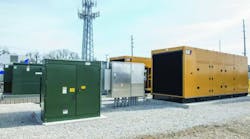Planning a microgrid is a tedious endeavor, often resulting in complex decision-making. However, there are enough microgrids now that experienced microgrid integrators should have a common assumption when starting a project: expect the unexpected.
Rarely do microgrid integrators get asked to create a “greenfield” microgrid, where all the technology is new. If you look at North America and other regions of the world with advanced grid infrastructures, it’s very difficult to find places that don’t already have electricity. As a result, almost all microgrid projects integrators design and develop are considered “brownfield.” The term “brownfield” means the site is existing, including electrical distribution, loads, and power system technology. The caveat here, however, is that the existing campus was not designed and developed to be a microgrid, uncovering the most challenging component of brownfield microgrid design.
The Ameren microgrid in central Illinois is a brownfield project. Despite bringing in all new generation sources and some new power system technology, it still had to interface with an existing utility distribution system, utility loads, and utility power system protection and control devices. The microgrid controller was seamlessly integrated into the project to allow the existing system to perform functions similar to what it did before the microgrid, but also have the enhanced features inherent with microgrid technology. Using such experiences and the many other microgrids S&C has built, I want to highlight three essential best practices all microgrid integrators should understand and follow:
Best Practice #1: The microgrid MUST be able to interface with existing equipment.
This is the most important best practice. As noted earlier, few microgrids are greenfield projects. As a result, integrators must be agile and flexible with their design, and they can’t think they’re going to be able to dictate every single aspect of the microgrid. They must recognize and be ready to face the fact they will have to interface with something that’s already there, and more than likely from multiple manufacturers having different technologies.
Integrating with an existing system can be done on multiple levels. That’s an interesting issue most people don’t even consider. Inexperienced integrators believe they’re going to go out and build a microgrid from scratch, with everything being brand new and specified by them. It doesn’t work that way. They’re going to work with existing components that were not solely designed to be microgrid-ready—things that might be older and have been on the site for a while.
Best Practice #2: People don’t know what they don’t know.
Plenty of folks want to get ahead of the pack and learn more about microgrids. But in my experience, I have seen a lot of different ways folks describe their perception of what microgrids can do and how to create one. So, through years of experience as a microgrid integrator, S&C has honed in on a clear understanding about what a microgrid’s capabilities are and what it can and cannot look like. We work to transfer as much of that knowledge as we can to the customer’s project.
When we have that initial customer conversation, it’s always difficult because the first thing we must do is make sure they’re grounded in what their microgrid will be able to do. There’s always a disconnect between what the customer wants to get and what’s feasible given the scope, schedule, and budget. As a result, we must first ground their understanding, making sure they have a good project scope and their numbers meet the financial, operational, and testing requirements to complete a successful project.
So, at this stage in the microgrid’s market maturity, many microgrid owners don’t know what they don’t know. This disconnect means we must do a fair amount of discussion to make sure the budget matches their microgrid expectations.
Best Practice #3: Be ready for change – lots of it.
We haven’t yet had a project where, after our initial design, the customer didn’t change their mind. So, after having started the process of ordering equipment, designing the software, developing the protection and controls scheme, and preparing for everything else, almost without exception the customer comes back and says, ‘you know, that’s not exactly the way that I want it to work.’ So, it’s important for microgrid integrators to understand the way a microgrid project starts isn’t the way it ends, and that’s OK.
Such situations illustrate the importance of having a solid microgrid control system. While microgrid integrators still must rein in certain project requests, such as those that may violate the protection scheme or when the requested sizing of the distributed energy resources isn’t properly sized to meet the load, a proper controller can support hundreds of different user-configurable fields. Microgrid owners can use these fields to change how their microgrid operates to best fit their needs.
For instance, if the owner wants to maximize a certain aspect of the microgrid, it can change that particular value on the controller. If the owner wants to set a different load prioritization that leads to load-shedding or it wants to switch between critical loads and noncritical loads, it can set dates, times, and other factors to control when and how the microgrid makes such decisions.
It’s the controller that provides the flexibility when the owner decides it may not want to operate the microgrid as originally planned. While it’s flexible in design, it still needs to allow for the customization that enables the owner to change and manipulate how the microgrid reacts in certain situations.
If you’re able to keep these three principles in mind, you’ll be sought after as a microgrid integrator because you’ll make the experience painless for the owner. More importantly, you’ll produce microgrids that deliver to their expectations.
Paul Pabst is assistant manager of SCADA engineering in the Power Systems Solutions Division of S&C Electric Company with nine years of experience in the electrical power industry.

